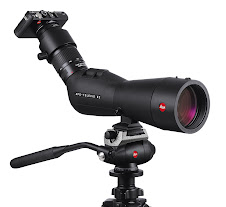

The product above is an older model, a Leica Trinovid 10x42 BN. Lets consider just the nomenclature on this product the "10x42" portion - "10x" describes the power of magnification. As you'd suspect, this binocular magnifies the subject 10 times. This means your subject will appear 10 times larger or 10 times closer than it does when viewed with your eyes alone.

The image above is a representation of a subject at 1x and 10x respectively. Unfortunately, at this size the graphic is not very effective because it is difficult to see well. The most popular powers of magnification in binoculars are generally 7x, 8x, and 10x. It is common for people to assume more magnification is better than less. However, it is important to remember that you are not only magnifying your subject, but you are also magnifying all the hand shake and movement from wind, etc.
Most people cannot hold a binocular with more than 10x magnification still enough to benefit from the increased power. As a matter of fact, many are surprised to realize that when comparing binocular models within the same manufacturer's line, that they resolve details better with a lower-powered binocular. When trying to decide which binocular is right for you, it is best to use a resolution chart (the optical equivalent of an eye chart). In lieu of a resolution chart, a dollar bill (or similar) usually offers suitable fine print for this test. Simply, hang one to the wall and compare which binocular power within a given line allows you to discern more detail. For me, I find I can discern more detail with a lower-powered binocular. I just can't hold a higher-powered glass steady enough to benefit from the increased power, and typically use a 7x42 binocular (7 times magnification) - I feel I see more detail on a smaller and brighter subject.

The second number describes the diameter of the objective lens in millimeters. The binocular above is an Ultravid 8x32. It magnifies 8x and the objective lens is 32 mm wide. In this binocular a 32 mm circle of light enters the binocular (the diameter of the objective), however for every 1x of magnification you must reduce the size of the circle of light entering your eye by the same power. Therefore, the circle of light seen coming out of the eyepiece & entering your eye is 32 mm divided by 8x, or 4 mm (see above). This circle of light is defined as the "Exit Pupil".

How does exit pupil affect binocular performance?.... Well again, all else being equal (assuming we are considering one particular line of a given manufacturer's products), a larger exit pupil means more light enters your eye.

In bright light, when your pupil is fully constricted, exit pupil is less important. However, in low lighting conditions your pupil dilates/expands. So an exit pupil of 4 mm may not fill every cone and rod in your pupil, where the 7x42 above with a 6 mm exit pupil will deliver a brighter image with superior resolution under these conditions. Also, as your hands shake, a smaller circle of light will be harder to stay over your pupil, while a larger exit pupil will continue to deliver consistent light to your eye. While your brain may well assimilate the image, over a full day's use your eye may feel more strain and discomfort with a smaller exit pupil, compared to the binocular with the larger exit pupil (once again assuming the same binocular quality/line).
Of course, this is but one consideration in binocular selection, and each individual will have to balance power & objective size, versus binocular size/weight & ease of use/ergonomics. This personal balance will obviously vary from user to user, but I think it safe to say that if "lightweight" and "compact" are two of your main criterion for binocular selection, it is true to suggest that within a given line, this cannot be achieved without sacrificing some optical performance. However, we will consider this fully in another post!














